
The following article has been converted to HTML format.

Johnny Nilsson
Swedavia, Sweden
ADS-B 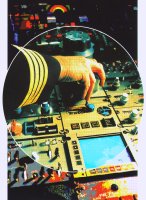
-future technology now
A unique surveillance capability enables position information to be constantly shared among all users - not just the ground ATC system
Automatic Dependent Surveillance Broadcast (ADS-B) is a aviation surveillance concept whereby aircraft transmit their positions (usually derived from a Global Navigation Satellite System (GNSS) receiver on board the aircraft) over a radio datalink. Position information is transmitted and received by every aircraft in the vicinity, so all users have knowledge of their own location and the locations of all other surrounding aircraft. The position information may be displayed in the cockpits of suitably equipped aircraft to give new location awareness capabilities. Ground vehicles and fixed ground stations can also be equipped to transmit and receive position data, allowing surveillance of all types of traffic and a two-way datalink capability.
In addition to position information, other data is broadcast on the datalink. Most importantly, this includes the aircraft identity (so that all users know the identity of all other users) and velocity of the aircraft, usually derived from the GNSS receiver.
ADS-B should not be confused with Satellite ADS (also known as ADS Contract or ADS-C). With ADS-B, an aircraft regularly and frequently transmits its position to all surrounding users, whether they are ground-based or airborne. However, with ADS-C the aircraft only transmits its position to a single ground centre with lower frequency, and as often as required by that ground centre.
The Swedish CAA is working with an ADS-B technology known as VDL Mode 4. It offers benefits to many different types of air and ground users. Some of the groups using VDL Mode 4 either operationally or for trials are:
ADS-B in the cockpit
Commercial aircraft operators, such as Lufthansa, SAS and Alitalia;
General aviation users;
Ground vehicle operators. For example, snow-clearing vehicles at Stockholm’s Arlanda airport use VDL Mode 4 to operate in poor visibility;
Helicopter operators, such as Maersk Air, which operates in the North Sea.
ADS-B will have a major impact on the cockpit environment because it will provide the pilot with full position awareness of all surrounding traffic (the aircraft flight number is automatically shown on the screen). Figure 1 shows a cockpit display that can be used to show the positions and intents of all the aircraft within 200 nautical miles. The display is known as Cockpit Display Traffic Information (CDTI) or as Traffic Situation Display (TSD) and is on trial in some SAS aircraft.
"An ADS-B ground station is a transmitting/receiving station without the expensive and complex rotating antennas of radar systems"
Pilots can use the cockpit display to monitor the traffic around them and to keep abreast of the traffic distribution. They can easily monitor essential traffic and for the first time will have the same surveillance picture as the controller.
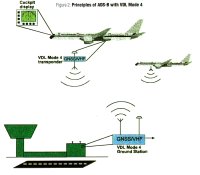
Figure 2: Principles of ADS-B with VDL Mode 4
The cockpit displays will support new manoeuvres such as station keeping, in which a pilot is asked to follow another aircraft maintaining a particular separation. This does not relieve ground controllers of their responsibilities for separation maintenance, but it does allow them to share some of their workload with the pilot. Station keeping can be used, for example, to sequence aircraft efficiently during departure operations.
Another application may be to allow passing manoeuvres in low-density oceanic airspace. Currently manoeuvres such as in-trail climbs are made using TCAS to provide separation assurance. This is not desirable because it involves the pilot specifically ignoring TCAS advisories during the manoeuvre, potentially causing confusion to the pilot and reducing the value of other TCAS warnings.
One of the benefits of the cockpit display is that it can replace the party fine, which refers to the way in which pilots listen to VHF radio to hear the exchanges between other pilots and the ground controller. By listening to the radio, the pilot builds up a mental picture of nearby traffic. Pilots are worried that introducing controller-pilot datalink communications (CPDLC) will remove the party line and they will therefore lose their present situation awareness. However, with an appropriate cockpit display, ADS-B gives a much better situation awareness to help overcome this concern.
ADS-B on the ground
On the ground, ADS-B will provide new surveillance capabilities to ATC at a fraction of the cost of conventional SSR. An ADS-B ground station is a transmitting/receiving station without the expensive and complex rotating antennas of radar systems. Further, unlike radar systems, an ADS-B ground station is not required to make high-precision measurements of aircraft position, so the cost of ground electronics is much less.
ADS-B will therefore offer an advanced and low-cost surveillance system to states that have areas without radar cover, with the following benefits:
High-quality surveillance data with gate-to-gate coverage, rather than a variable quality of surveillance cover depending on the phase of flight and ground station siting;
Low cost. There would be no separate surveillance system since it would be part of the communication infrastructure already in place;
Flexibility. Surveillance reporting rates can be varied according to the requirement. For example, PRM monitoring can have a higher reporting rate than en route applications;
More accurate data. GNSS position data has an accuracy of a few metres if differential corrections are available to the GNSS receiver. This is a much higher accuracy than most radar systems. Also, the velocity information given by a GNSS receiver is more accurate than velocity derived from consecutive radar tracks;
More advanced surveillance information. For example, additional data from the FMS or other airborne computers may be transmitted over the datalink to other users;
Support for new applications. A general purpose datalink can be used to pass additional surveillance information or support new applications;
Identical surveillance information available to all users, including airborne and ground-based users. In remote areas, aircraft could use this surveillance data for autonomous control;
Suitable for all phases of flight, including airborne and surface movement surveillance.
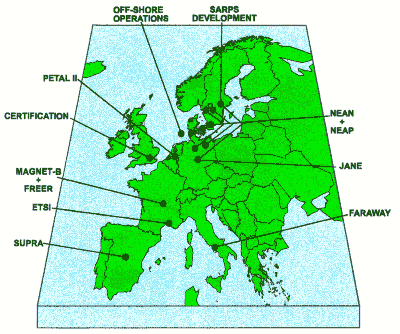
Figure 3: European ADS.B VOL Mode 4/STDMA activities
Mode 4 - a solution for ADS-B
VDL Mode 4 is a Swedish-developed technology for ADS-B and other datalink communications, navigation and surveillance (CNS) applications. VDL Mode 4 is based on a VHF datalink technology known as self-organising time division multiple access (STDMA). VDL Mode 4/ STDMA provides a real-time two-way datalink, for all aviation applications, as well as ADS-B functionality.
VDL Mode 4 has been presented for standardisation in the ICAO Aeronautical Mobile Communication Panel (AMCP). In addition, EUROCAE WG 51 is developing MOPS standards for VDL Mode 4 and ETSI is considering standardising on VDL Mode 4.
There are many projects around the world that are using prototype VDL Mode 4/STDMA equipment; Figure 3 shows some of those in Europe. Most of the projects involve the Swedish Civil Aviation Administration, and most European ones are sponsored by the European Commission (EC) or Eurocontrol.
There is insufficient space in this article to describe all the projects using VDL Mode 4/STDMA, but some are:
NEAN (Sponsored by EC DGVII)
The largest European activity is known as the North European ADS-B Network (NEAN). Under NEAN, an ADS-B capability is being created through a network of ground stations and mobile VDL Mode 4 equipment that is being installed in commercial aircraft and airport vehicles. The network spans Germany, Denmark and Sweden, and once position reports are received by a ground station they are distributed throughout the network to air traffic control and other users. There will be 15 ground stations in the NEAN project and 16 aircraft equipped, including four 747s, two DC9s, two F28s and a helicopter involved in North Sea operations. Around 30 ground vehicles will also be equipped. Figure 4 shows the coverage of NEAN ground stations and Figure 5 shows recorded surveillance data from an SAS Fokker 28 during a month’s flying in the NEAN project.
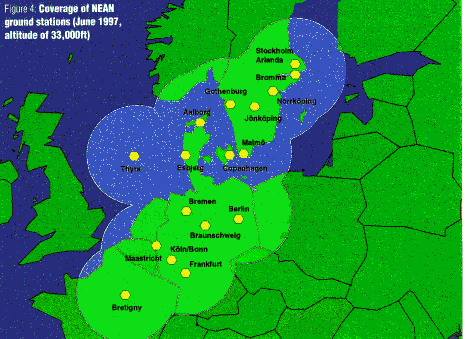
Figure 4: Coverage of NEAN groundstations (June 1997, altitude of 33,000ft)
NEAN is a collaborative venture between the German, Danish and Swedish Civil Aviation Administrations and the following aircraft operators: Lufthansa, SAS, OLT, Maersk Helicopters and Golden Air. The UK CAA is leading the certification and validation parts of the project. The NEAN ground network was completed in May 1997 and airborne installations will be completed in the second half of 1997.
In June 1997, Flight International gave an Aerospace Industry Award to Luftfartsverket (the Swedish CAA) and SAS. The award was for ‘pioneering work within the NEAN project to demonstrate the potential of ADS-B’.
"VDL Mode 4/STDMA provides a real-time two-way datalink, for all aviation applications, as well as ADS-B functionality".
NEAP (Sponsored by EC DGVII)
The North European CNS/ATM Applications Project (NEAP) is a sister project to NEAN, with the same participants. Using the infrastructure implemented in NEAN, NEAP will develop and demonstrate end-to-end (airborne and ground-based) applications using the VDL Mode 4/STDMA datalink. The applications to be investigated in NEAP include: enhanced ATC surveillance (both while airborne and on the ground); uplinked support information for pilots (such as ATIS data); uplinked differential GPS corrections; and integrity data.
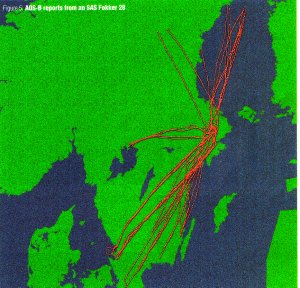
Figure 5: ADS-B reports from an SAS Fokker 28
Faraway (Sponsored by EC DGXIII)
The objective of Faraway is to investigate the enhanced operational performance of ground surveillance and aircraft navigation made possible through fusion of radar and ADS-B data. The Faraway project is coordinated by Alenia SpA, Italy, and involves ATM service providers and airlines in Germany, Italy and Sweden. Initially, three Alitalia MD-82s will be equipped with VDL Mode 4/STDMA and cockpit display equipment, and one ground station will be installed at Ciampino airport, Rome. The Faraway trials will run from October 1997 to March 1998.
Supra (Sponsored by EC DGXIII)
This project is coordinated by Indra of Spain and focuses on the use of ADS-B and cockpit displays for general aviation aircraft and airport ground vehicles. Within the project two general aviation aircraft and one ground vehicle have been equipped at El Robledillo airport outside Madrid. A VDL Mode 4/STDMA ground station has also been installed for uplinking DGNSS messages and ATIS reports. Successful demonstrations of the Supra installations were completed in April 1997.
Magnet B (Sponsored by EC DGXIII)
The objectives of Magnet B are to develop GNSS l user segments, to assess their ability to meet the most demanding aviation requirements and to evaluate the benefits that users can achieve from the integration of GNSS1 with a two-way datalink. The Magnet B project is coordinated by Dassault Electronique, France, and includes participants from Germany, the UK, Norway, the Netherlands and Sweden.
Petal II (Sponsored by Eurocontrol)
Petal II is a Eurocontrol project investigating use of an air/ground datalink for real-time CPDLC. Petal II is using the two-way datalink capability of VDL Mode 4/STDMA to provide this application. VDL Mode 4/STDMA ground stations were installed at the Maastricht Centre and at the Eurocontrol Experimental Centre in March/April 1997.
Offshore helicopter operations
Companies in Denmark and Norway are installing VDL Mode 4/STDMA equipment on helicopters flying personnel and supplies to oil rigs in the North Sea. The first installation on a Super Puma helicopter was completed in February 1997.
In addition, there are activities underway in the rest of the world. For example, a test programme has been performed by the FAA at Atlanta Hartsfield airport, USA, to evaluate VDL Mode 4/STDMA for ADS-B, GNSS ground augmentation and uplink of traffic information (TIS-B), and to compare the performance capabilities of different ADS-B systems.
"The Swedish CAA believes that VDL Mode 4 is the only technology that can deliver the benefits of ADS-B. This view is supported by major airlines"
Conclusions and future plans
ADS-B is a technology that can provide pilots with accurate information about surrounding air traffic and offers important operational benefits. In addition ADS-B will bring other benefits, not least reduced surveillance costs and greater surveillance capability and flexibility.
The Swedish CAA believes that VDL Mode 4 is the only technology that can deliver the benefits of ADS-B. This view is supported by major airlines such as Lufthansa and SAS, which are actively involved in VDL Mode 4 development.
Plans are to progress with VDL Mode 4 pre-operational trials to work towards operational systems. The Swedish CAA will aim to deliver new services based on the principles of early delivery of benefits to airlines and the incremental introduction of services, starting with low-criticality applications that have the lowest certification requirements. These applications will be used to gain operational experience and confidence.
Pre-operational experience is already being gained in the NEAN project and in the other programmes described in this article to assist in a fast transition to the new services and benefits that are offered by ADS-B.
Press clip as MS WORD dokument